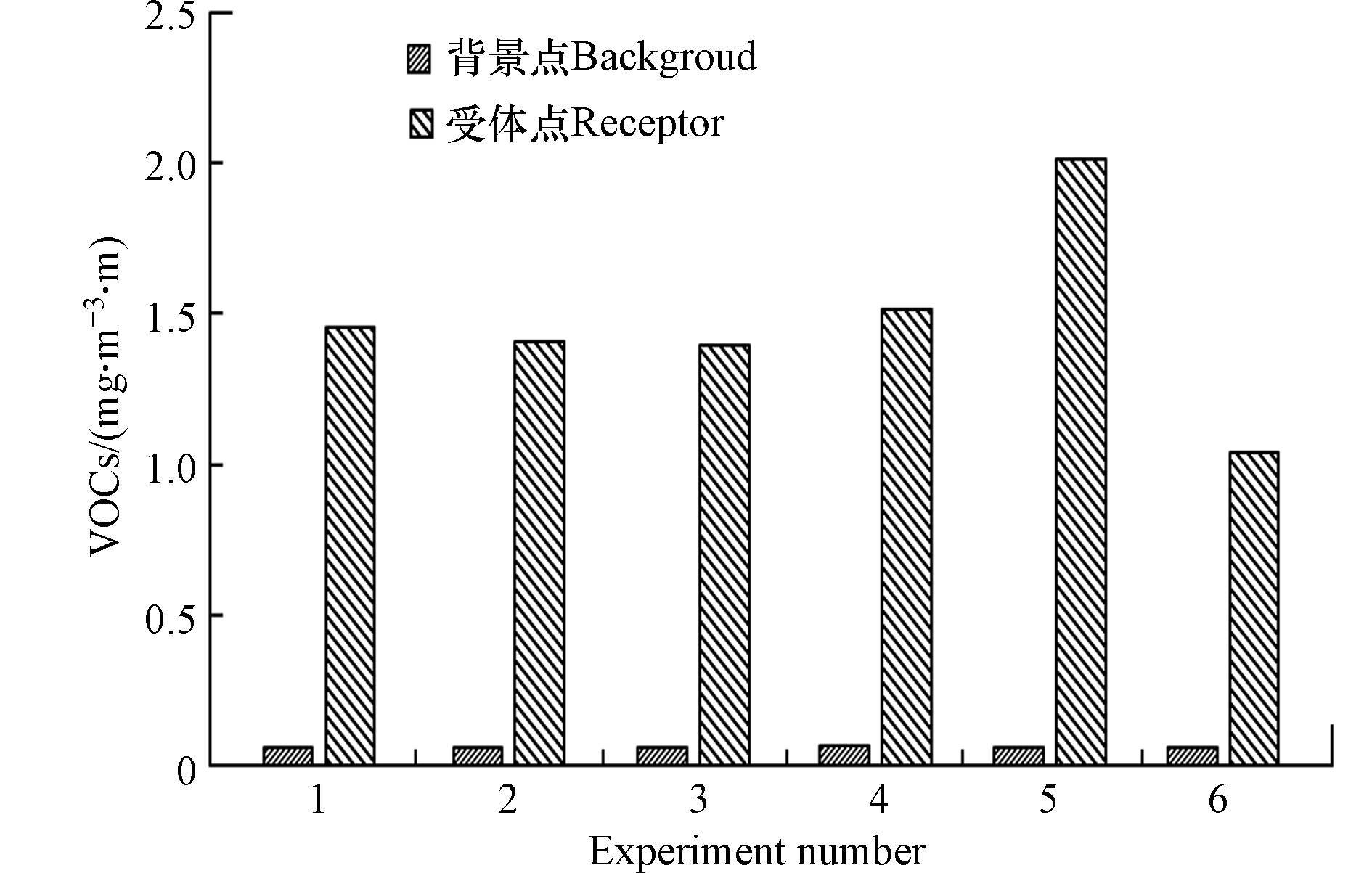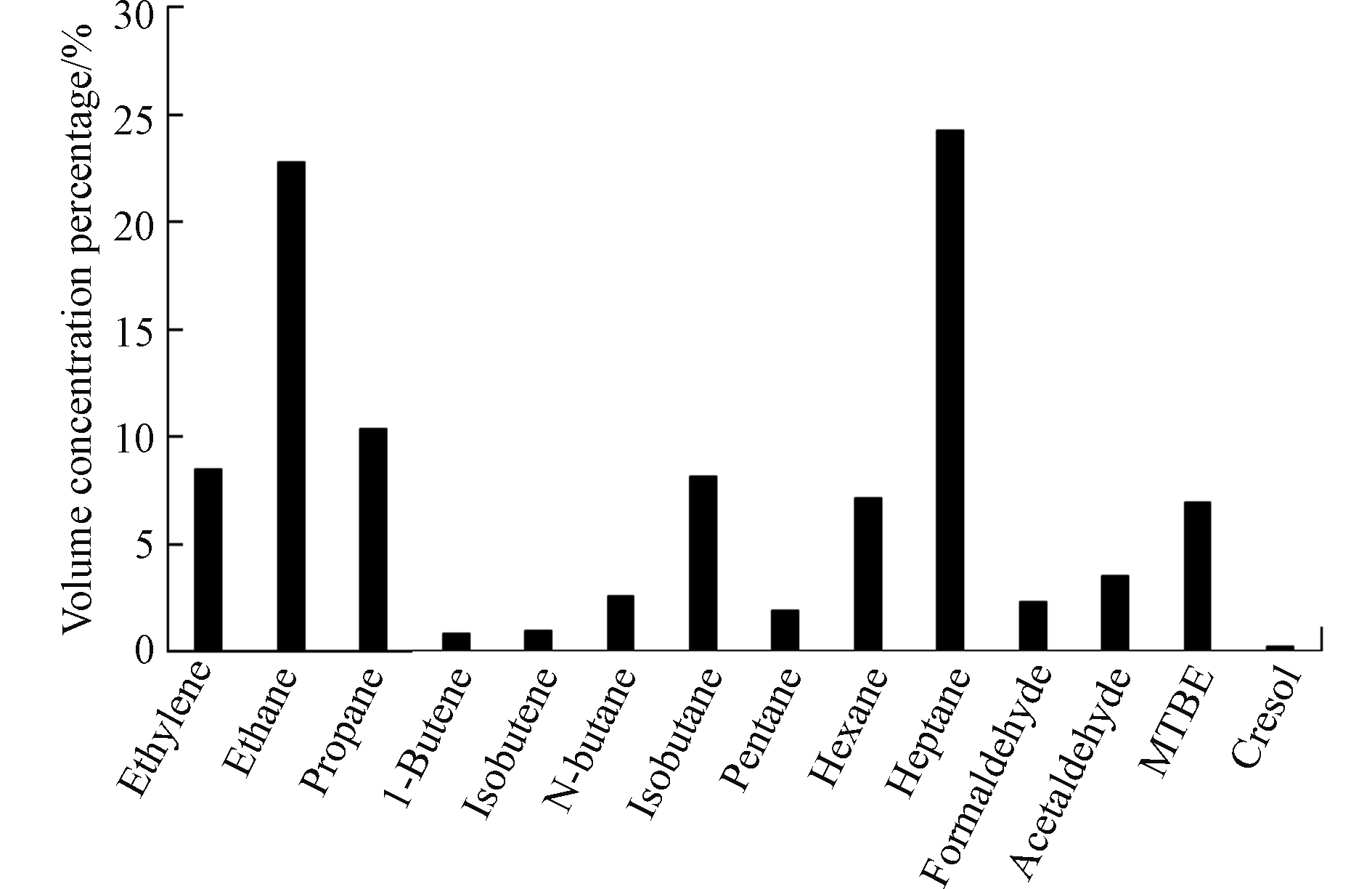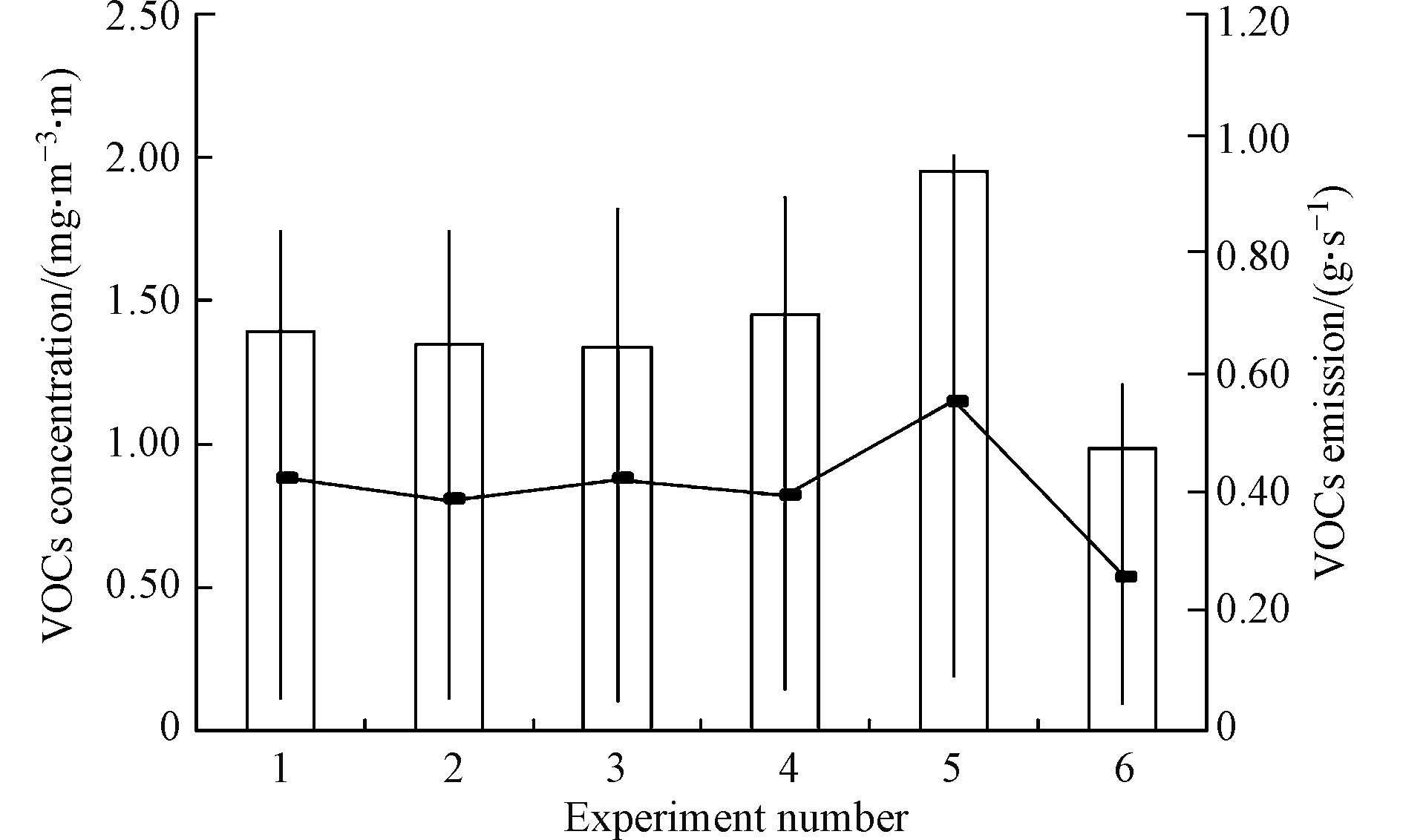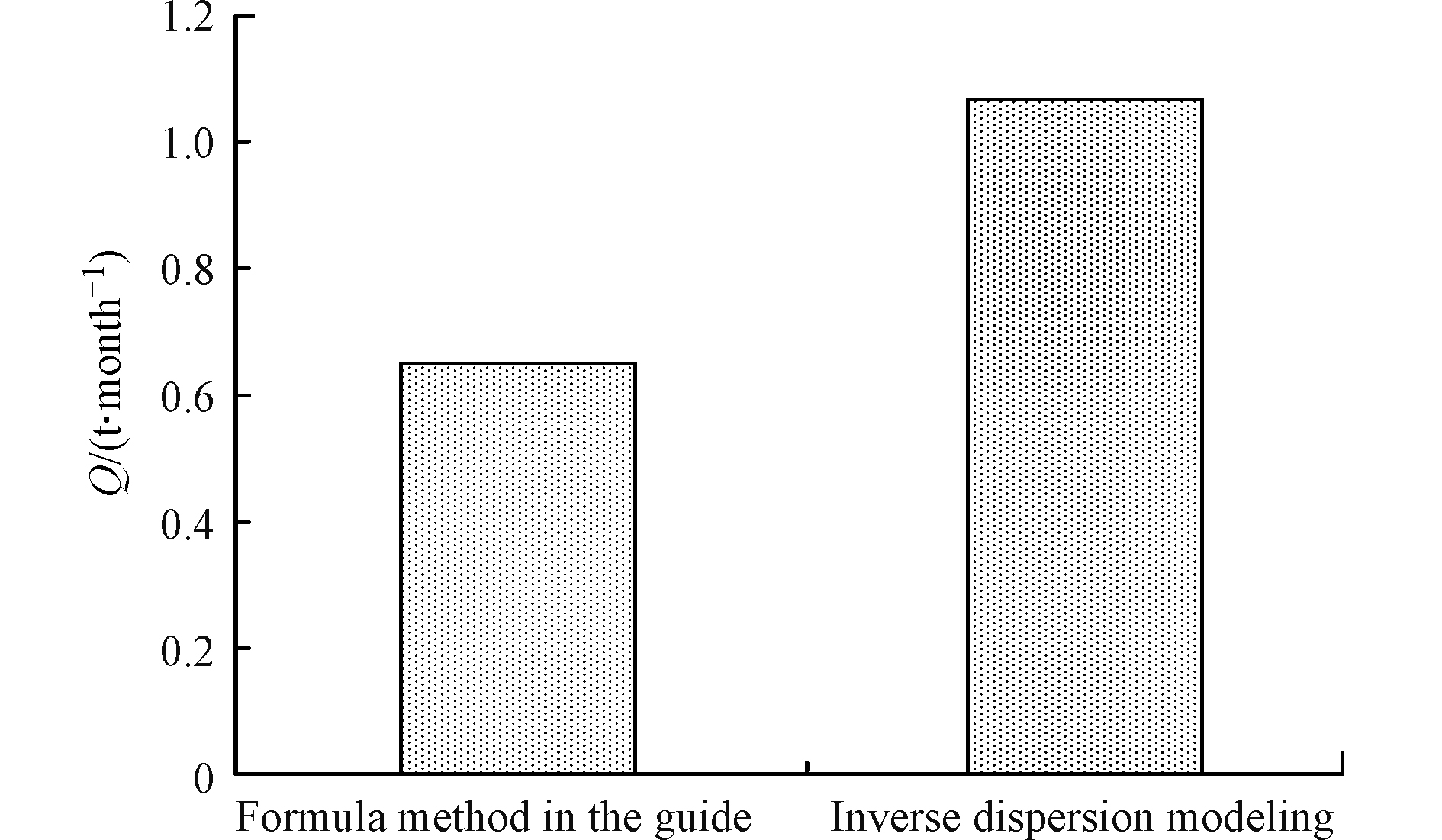-
石化企业是国民经济的支柱产业,给国民带来了极大的能源和经济利润,同时也属于重大的污染源。其中大气污染以无组织排放为主,污染物主要是种类繁多的挥发性有机污染物(VOCs)。挥发性有机污染物(VOCs)是一类常见的大气污染物,是臭氧和二次有机气溶胶的重要前体物[1-2],本身也具有毒理特性,对人体肝脏、血液健康等具有剧烈的生理毒害作用[3-4],部分污染物三氯甲烷、四氯乙烯、苯等对人体甚至有致癌、致畸、致突变作用[5],其污染物排放清单和污染物排放特征研究引起国内外学者的广泛关注。
储罐是石化企业最常用的生产装置,更是最主要的无组织排放源之一,据统计,我国每年约有千万吨级的VOCs从有机液体储罐挥发到大气中[6];美国2003年的一份调查显示,在美国18家石油公司各项污染源VOCs排放量中,储存过程中VOCs排放量约占总排放量的29%[7]。自储罐产生的无组织排放VOCs,一方面降低了油品质量、造成了资源的大量浪费,另一方面排放的大气污染物严重危害了人们的生命健康和生态环境,并带来了一系列的安全问题[8-10]。
目前世界各国自有其适用的储罐无组织排放VOCs定量方法,或是半经验半理论法,或是纯经验法,比如美国环保署EPA推荐方法、美国石油协会API经验法、日本资源能源厅方法等。我国亦于2015年出台了《石化行业VOCs污染源排查工作指南》,然而工作指南中的核算方法是以EPA推荐方法为基准的,相关参数也是基于美国储罐构造现状推导出的,而由于在原料品质、储罐设计标准和管理水平等方面的差异,并不能完全适用于我国。
扩散模式反推法,计算精准、需求污染源信息少、示踪气体扩散过程拟合效果好,是工业点源、面源污染物排放量核算的重要方法,在工业无组织排放源强特征研究中应用广泛[11-14]。然而传统的扩散模式反推法,多采用以电化学和气相色谱为主的定点采样分析方法,就其本身而言,具有采样分析过程复杂、耗费人力物力大、测量范围小、只能反映监测区域定时、定点、局部的监测结果,不能实现大范围区域环境监测,无法实现实时在线自动监测,不能满足及时、准确、全面反映环境质量动态和污染源动态变化的需求。
随着科技的进步,环境监测技术的发展,仪器分析以及计算机技术的广泛应用,各国科技工作者将遥感技术广泛应用于大气环境自动监测系统。本文以遥感FTIR技术为基础,提出了一种针对于石化罐区VOCs源强的核算方法:基于遥感FTIR的扩散模式反推法[15],旨在为我国石化罐区无组织排放VOCs核算方法的构建提供数据、技术支持。
全文HTML
-
如果已知污染源下风向某点位的浓度及影响排放的相关信息,根据大气扩散理论,则可以计算出污染源的排放量,这是传统扩散模式反推法的理论基础。与传统的扩散模式反推法相比,本文所建立的源强反演模型的创新点在于以遥感FTIR技术取代了传统的定点监测技术,摆脱了以电化学和气相色谱为代表的定点采样分析方法所带来的局限性问题,并同时保留了遥感FTIR监测技术与扩散模式反推法两者的优势。
FTIR是一种基于光的干涉原理基础上进行了傅里叶变换的红外光谱监测技术,近年来,取得了迅猛的发展[16]。遥感FTIR能够实现大范围的环境监测,具有更强的实用性,在环境监测中具有良好的应用前景[17],但在研究气体组分或颗粒物浓度时,遥感FTIR的测定结果只能获得光路积分浓度数据(path integrated concentrations),不能直接反应待测参数(如气体浓度)在空间的分布,应用受到了限制。
如果一个模型能够精准的模拟大气污染物的扩散过程,任何可以测量且与大气扩散模型及污染物排放量Q相关的指标都可以用来表征大气污染物排放量Q。光路积分浓度PICs即为一合适指标,既避免了遥感FTIR不能直接反应待测参数(如气体浓度)的难题,又发挥了光路积分浓度的优势,如避免了定点采样分析所带来数据波动性问题,可以进行大范围的现场监测、测量速度快、灵敏度高、反应大范围浓度变化等[18-19]。
扩散模式反推法成功的关键其一便在于选择合适的大气扩散模型,考虑到模型的工程适用性,选择工业上应用最为普遍且经过大量实验验证过的高斯模型。在工程应用中,多将石化罐区简化为面源进行处理,常用的面源模式计算方法主要有两种,即ATDL模式和虚点源模式后置法。相比更适用于城市尺度大范围计算的ATDL模式,后置虚点源法更适用于工业面源。
反演模型成功的关键其二在于光路积分浓度PICs与排放量Q之间联系的建立。由于高斯模式在数理上具有解析形式,极大的降低了PICs与Q之间关系建立的难度。即基于监测光路与主导风向垂直假设,将点式浓度沿监测光路积分,依托高斯大气扩散模型,则可构建公式(1):
式中,
$ u $ 为H高度处平均风速(m·s−1),$ {\sigma }_{y} $ 为水平方向扩散参数(m),$ {\sigma }_{{y}_{0}} $ 为水平方向初始扩散参数(m),$ {\sigma }_{z} $ 为垂直方向扩散参数,$ {\sigma }_{{z}_{0}} $ 为垂直方向初始扩散参数(m);$ {C}_{\mathrm{L}} $ 为受体光路监测浓度(mg·m−3·m),$ {C}_{\mathrm{b}} $ 为背景光路监测浓度(mg·m−3·m),x为顺风向距离(m),y为横风向距离(m),H为有效源高(m),$ {Q}_{\mathrm{P}} $ 为污染源监测时段的排放量反算结果(mg·s−1)。 -
本研究所选取的20万m3石脑油实验罐区,位于我国北方地区某石化企业烯烃部东南角,罐区北侧和西侧周边有稀疏的建筑物,且高度普遍较低,西北角约500 m处有一污水处理装置,南侧和东侧为开阔荒野地带,无公路以及其它交通设施,车流量极少,其它污染源的影响较小,满足反演模型的应用条件。
在进行外场监测之前,进行了近一周的气象观测和现场勘查,以确定上下风向的监测点位,气象观测表明主导风向为西风,在该风向条件下,20万m3石脑油罐区的上下风向均有足够的开阔地,以布设OP-FTIR及辅助设备。
外场监测工作于2017年10月份持续进行了6 d,每天至少进行6 h上下风向连续不间断的光谱数据与气象数据同步采集,其中背景光谱数据采集在主导风向的上风向实施,VOCs排放光谱数据采集在主导风向的下风向进行,气象数据采集主要包括风向、风速、云量、温度、监测时间、大气压强等。外场监测布设详见图1。
在进行现场应用之前,已于我国北方某实验基地进行反演模型准确性验证及边界适用条件探索,研究表明,其监测点位的设置及数据采集分析处理应遵循以下原则:(1)背景监测点位应设置在主导风向的上风向,光路至污染源的监测距离应足够长,以避免污染源自身扩散对背景点位监测的干扰;(2)VOCs排放监测应设置在主导风向的下风向,监测距离需适中,以保证污染物扩散均匀,并满足所选用仪器设备的灵敏度需求,监测极限距离由监测设备与现场地形条件共同决定;(3)根据主导风向布置OP-FTIR主机与角锥反光镜,以保证主导风向与光束路径近似垂直,风向波动角度以小于15°为宜;(4)风速、大气稳定度、数据采集周期等分别以>1 m·s−1、C—E、15—60 min为宜,在本实验中以15 min为一个数据采集周期。
1.1. 源强反演模型构建
1.2. 实验方案
-
外场实验在2017年10月份开展,由于进行了6 d连续监测,风速、风向等气象条件也极为相近,具体数据采集状况如表1所示。
经过6 d的外场实验,共计采集光谱及气象数据76组,通过遥感FTIR监测仪对光谱数据进行分析,共计检出14种VOCs化合物,包括7种烷烃、3种烯烃、1种苯系物以及3种醛醚酚等其它化合物,将其浓度之和定义为VOCs。根据监测时间,将监测数据编为实验1—6,其背景点与受体点VOCs浓度如图2所示,实验5、实验6受体点VOCs浓度虽有一定波动,但整体上14种VOCs化合物的光路积分浓度均比较稳定,标准偏差约为0.31,说明20万m3石脑油罐区VOCs无组织排放稳定,适用于源强反演模型进行源强反演,此外受体点与背景点VOCs浓度存在明显差异,显示了罐区无组织排放VOCs对周边环境的显著影响,针对于实验5、实验6受体点VOCs排放浓度的差异性,后续将结合核算结果作进一步分析。
-
受体点和背景点不止在VOCs浓度方面有着明显的区别,更在污染物成分上有着显著差异。在背景点中乙烯、乙烷所占比例最大,特别是乙烯占总体积浓度的30%,而在受体点中,乙烯的体积浓度百分比明显降低,仅占总体积浓度的8.48%,乙烷、庚烷的浓度明显增高,约占总体积浓度的50%。受体点和背景点之间VOCs的浓度差异以及污染物化学成分上的明显差异表明,20万m3石脑油罐区VOCs排放量大,对局地大气环境影响明显,可以使用源强反演模型进行VOCs排放量反演。
将剔除了背景点浓度的受体点VOCs作为该20万m3石脑油罐区所做的贡献,并以之来组成20万m3石脑油罐区VOCs排放成分谱图,其中14种主要的化合物体积浓度百分比如图3所示,20万m3石脑油罐区排放的VOCs主要成分为乙烯、乙烷、丙烷、异丁烷、己烷、庚烷、甲基叔丁基醚,其体积浓度百分比分别为8.48%、22.73%、10.35%、8.10%、7.11%、24.22%、6.90%。
-
表2以10月10日实验1为例进行说明,依据本文提出的源强反演模型对14种主要污染物进行源强反演,以14种污染物之和作为VOCs的主要代表物质,进而计算20万m3石脑油罐区VOCs的排放量Q,其中∆C代表两者的浓度差值。
本研究共计进行了6组实验,获得了76组实验数据,将6组实验的VOCs源强反演数值总结至图4。如图4所示,前4组实验VOCs浓度基本保持稳定,在1.38 mg·m−3·m上下波动,而实验5、实验6 VOCs浓度存在一定差异,分别为1.95 mg·m−3·m和0.98 mg·m−3·m,同时反映到20万m3石脑油罐区VOCs年排放量上也有相似的规律,以前4组实验稳定数据作为20万m3石脑油罐区的核算基准,可得其排放量为0.38—0.42 g·s−1,均值为0.41 g·s−1,而实验5与实验6的核算结果分别为0.55 g·s−1和0.26 g·s−1。
对6组实验数据中的异常结果进行分析,实验5,污染物VOCs浓度明显高于其它实验,经与企业工作人员协商,罐区运行状态并无异常,与其它监测时段运行状态一致,下风向受体点污染物VOCs浓度偏高是受到西北侧污水处理单元的影响,而导致监测浓度并不仅仅来源于20万m3石脑油罐区,而是多源的叠加,监测数据明显异常,进而导致源强反演结果明显过大,实验6,参考采集的气象数据,实验6主导风向成西-西南风,而20万m3石脑油罐区西南侧为空旷地带,导致监测数据有所减小,亦使得数据的采集不符合反演模型的适用要求,反算结果误差较大。
-
虽然通过源强反演模型对20万m3石脑油罐区无组织排放VOCs进行了源强反演,源强反演结果稳定,但是为了比较反演结果的准确性,仍需要与其它核算方法进行比较分析。
当下国内外主要的石化罐区无组织排放核算办法可分成两种,一种是半经验半理论方法,主要包括美国EPA推荐方法、中国《石油库节能设计导则》方法、中国石油化工(CPCC)估算法等,另一种是纯经验方法,主要包括美国石油协会(API)经验方法、欧盟排放系数方法[20]等。
我国亦于2015年出台了《石化行业VOCs污染源排查工作指南》[21],然而工作指南中的核算方法是以EPA推荐方法为基准的,对于罐区的无组织排放VOCs核算亦是如此,相关参数也是基于美国储罐构造现状推导出的,而由于在原料品质、储罐设计标准和管理水平等方面的差异,并不能完全适用于我国。尽管如此,工作指南中的核算方法,仍然是我国目前最主要的VOCs核算方法。如图5所示,模型反演结果与工作指南核算结果有一定差距,其中工作指南核算结果为0.65 t·month−1,计算结果来源于所研究炼化企业根据工作指南的自身核算,而源强反演核算结果为1.07 t·month−1,反演核算结果约比工作指南核算结果高45%。
综合考虑指南核算方法与源强反演核算方法,从两个角度对图5的结果进行分析,指南核算方法以EPA核算方法为依托,EPA推荐的核算方法,综合考虑了各种储罐和储存物料,计算过程考虑了各种影响因素,并具有缜密的公式推导和实验基础,然而针对于储罐无组织排放的VOCs核算自然是以美国的自身状况为基础,其气候条件、罐体特征、管理方法、控制措施等与我国存在一定的区别,使得该方法在美国适用良好,在我国进行的石化现场核算必然存在一定差距,国外的许多核算方法在我国石化企业直接使用,会造成较大的误差,不宜直接使用。
基于遥感FTIR-扩散模式反推的源强反演方法,前期通过模拟气体释放实验,已验证该反演模型反演结果稳定可接受,其中模拟误差<15%,然而在现场的实际应用中还存在来自现场监测环境、气象条件以及储罐自身运行状态等因素的影响,以此评估储罐VOCs排放状况,误差范围会进一步扩大,不过,45%的差距仍是难以接受,分析可能与温度等气象条件有关,现场监测的数据采集是在晴朗的白天进行,并以此为基础推算10月份的VOCs排放量,没有考虑到夜晚低温带来的低排放量状况,而导致整体核算结果偏高。
2.1. 20万m3石脑油罐区周边VOCs浓度及化学组分分析
2.2. 20万m3石脑油罐区VOCs排放成分谱
2.3. 20万m3石脑油罐区VOCs排放源强反演
2.4. 经验公式法计算罐区排放VOCs
-
针对于石化罐区无组织排放VOCs,建立了同时具备遥感FTIR和扩散模式反推法两者优势的源强反演模型,摆脱了遥感FTIR在不能直接反映待测参数(如气体浓度)在空间的分布方面的限制,拓宽了遥感FTIR技术的应用范围,亦避免了传统扩散模式反推法在定点采样分析方面的缺陷。
为了更详尽地检验源强反演模型的实际应用状况,同时为我国石油炼制行业储罐区VOCs排放特征提供参考,为工业面源VOCs排放量计算方法的构建提供数据支撑,在我国北方某石化企业20万m3石脑油罐区进行了现场应用实验。研究表明:(1)监测时段内20万m3石脑油罐区VOCs无组织排放稳定,受体点与背景点在VOCs浓度及化学组分上存在明显差异,20万m3石脑油罐区VOCs排放量大,对局地大气环境存在明显影响;(2)以扣除了背景浓度的受体浓度VOCs作为20万m3石脑油罐区所在的贡献,获得了20万m3石脑油罐区VOCs排放成分谱图;(3)针对20万m3石脑油罐区,分别以源强反演模型和指南公式法对其10月份VOCs排放量进行计算,结果分别为1.07 t·month−1、0.65 t·month−1,两者存在一定差异,分析主要原因是指南公式法在我国应用的不适用以及监测时段的温度条件所致。
虽构建了针对于罐区无组织排放VOCs的源强反演模型,也通过模拟实验检验了该模型核算结果的准确性,但现场应用条件的复杂性,打破了模拟实验的反演误差,为了准确确定污染源VOCs的排放状况,需进行长期的现场监测,综合考虑环境温度及装置的运行状态,并将排放量与之建立数量关系,以量化反演模型的准确性。




 下载:
下载:













